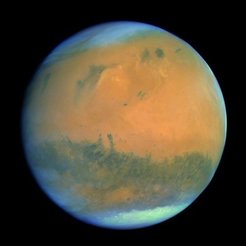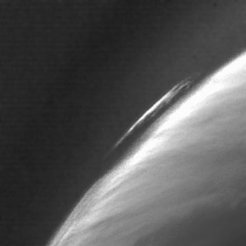OSIRIS collected spectacular images of Mars during the Rosetta flyby
An important observing opportunity of Osiris, before Rosetta arrives at 67P/Churyumov-Gerasimenko in 2014, is the Mars swing-by. Rosetta requires the Mars flyby to gain acceleration on a complicated trajectory. OSIRIS was actived during this close fly-by of Mars, and acquired beautiful images of the red planet on 24 February.
Due to the unique dynamic range and the filters of OSIRIS, new valuable information about Mars is expected. Researchers from the OSIRIS Team (PI: Uwe Keller from the Max Planck Institute for Solar System Research (MPS)) are currently working on the analysis of the data.

The above image composite is based on near-infrared, green and near-ultra-violet colour information obtained by the OSIRIS Narrow Angle Camera. At the southern part of the planet, the southern spring polar cap is clearly seen. At this time of the Martian year, a large fraction of Mars' atmosphere is evaporating from the southern polar cap and will migrate to the northern polar cap during northern winter. Over most of the Martian disk one can see large cloud systems.
ESA ©2007 MPS für OSIRIS-Team MPS/UPD/LAM/IAA/RSSD/INTA/UPM/DASP/IDA

This image taken by the OSIRIS Narrow Camera shows atmospheric structures.
ESA ©2007 MPS für OSIRIS-Team MPS/UPD/LAM/IAA/RSSD/INTA/UPM/DASP/IDA

The rosetta lander in front of the OSIRIS data reduction team (From left to right):
Rainer Kramm, Sonia Fornasier, Michael Küppers, Alice della Stella, Olivier Groussin, Ivano Bertini, Giampiero Naletto, Luisa Lara, Vania da Deppo, Horst Uwe Keller and Stubbe Hviid
Missing: Nick Thomas, Miriam Rengel and Holger Sierks
Rainer Kramm, Sonia Fornasier, Michael Küppers, Alice della Stella, Olivier Groussin, Ivano Bertini, Giampiero Naletto, Luisa Lara, Vania da Deppo, Horst Uwe Keller and Stubbe Hviid
Missing: Nick Thomas, Miriam Rengel and Holger Sierks
MPS, A. Blome


